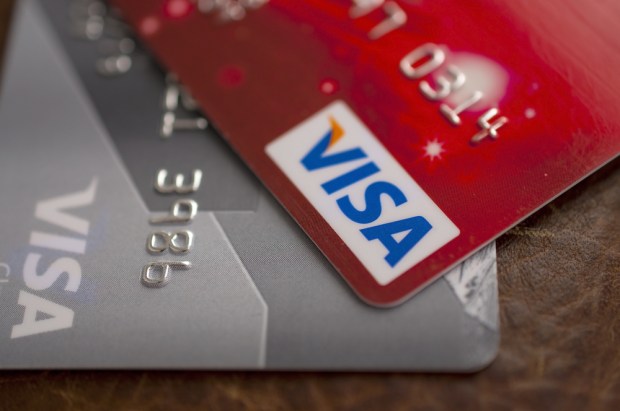Visa CEO At JPMorgan Tech Confab: Progress Continues in Europe, Contactless Payments

On Tuesday (May 15), Senior Analyst Tien-Tsin Huang of JPMorgan Securities interviewed Visa CEO Alfred Kelly at the JPMorgan Chase Global Technology, Media and Communications Conference. In the interview, Kelly offered up details beyond the earnings call that was held last month, covering topics as far-flung as Europe, contactless payments and buy buttons, according to a transcript released by Seeking Alpha.
Huang asked about some of the positive surprises or points of pride beyond the earnings release, and Kelly noted that “the continued progress we’re making in Europe probably comes top of mind to me … As of a couple of weeks ago, we’re finished the migration of all of our clearing and settlement from the legacy European system on to our global VisaNet system. We began, about two weeks ago, the migration of all of authorization.”
He continued, “We did the clearing and settlement migration in four tranches over a two-month period. The authorization is going to be converted account-by-account, so there is going to be 500 or so individual conversions. [We’ve] probably done about somewhere in the mid-teens so far, and this will continue over the next five to seven months, and then we’ll be completely converted. And that will be the last big step of the integration.”
Kelly also told the conference that “we’re really starting to pick up traction on our push payment Visa Direct capability. We’ve chosen a path of going down and utilizing our rails for push payments rather than trying to piece together country-by-country an ACH network to facilitate this. And we’re obviously behind a number of the P2P payments, but we’ve also started to get into other use payments that are allowing us to really push Visa Direct in big ways.”
The CEO added that his company continues to make progress with its efforts in contactless payments, saying that beyond the lack of progress in the United States, “we’ve seen really good progress around the world.”
He noted that, a year ago, one out of every eight global transactions processed by the company was contactless, moving up to one in five last quarter.
“And the U.S., [a] year ago, was 40 percent of the non-contactless transactions,” he said. “Now, the U.S. is half of the non-contactless transactions in the United States. So we’re obviously very focused on getting contactless going in the U.S. … It’s going to be a bit of a journey. But over the next couple of years, we’ll start to make progress on contactless in the United States, because it only makes sense because it’s a better transaction for the merchant and it’s a better transaction for the consumer.”
Speaking generally, Kelly stated that Visa remains a “very macroeconomic business. So even when a deal is announced in a quarter, it’s quarter’s out before it really has impact.”
Looking at individual markets, in some ways the United States may be mature, but Kelly noted that roughly $3 trillion is spent via cash and checks by consumers. The CEO said that the company is setting its sights on “the long tail of smaller merchants … we have to do a better job of educating consumers and merchants … of the expense to them of dealing with so much cash.”
He said that eCommerce is a growth factor in the U.S. B2B remains promising, as well, as 10 percent of transactions in that space are card-based. Large-ticket activity holds potential for Visa in the U.S., too.
“We’re spending a lot of time thinking about things like rent and education, insurance, and those kinds of things,” he said.
Announced by Visa earlier this year, the company dropped the signature requirement, with Kelly saying, “The real reason we decided to go for it was we want to force adoption of the EMV. So reality is that we said no signature required for merchants that are EMV-compliant. So we wanted it to be a stimulus to try to continue to drive EMV, because that’s a known proven way to drive down fraud in the industry. The second thing I’d say about all of this is that 75 percent of transactions on Visa in the United States didn’t require signature before this, because they were under various limit.”
Huang asked about eCommerce, with the impetus for a shared buy button among payments players. Kelly answered, “So one of the things I’ve been extremely vocal about internally in Visa, for the last 18 months, is my strong discontent with the Checkout experience in eCommerce. What we have today is the moral equivalent of having to ask them — a face-to-face merchant — to have a different terminal for each network. Imagine the confusion at the point of sale, if you had seven or eight terminals and the checkout person has to actually determine which card you have and go to the right terminal, et cetera. That’s in essence what’s happening in eCom.”
Payments Service Directive 2 (PSD2), said the executive, looms and “I think PSD2 is something that is going to help us and play to some of our strengths. You’ve got the core two factor authentication as the key element of it, we know a lot about authentication. And I think [Visa] can help build solutions for the banks to make sure they’re complying with PSD2 on dual factor authentication. … I think it opens up the opportunity for various new use cases around facilitating mobile technology and maybe real-time payments capability.”
